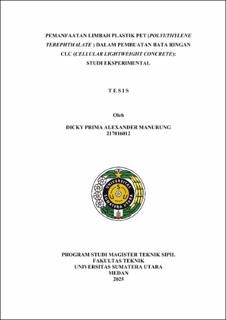Pemanfaatan Limbah Plastik PET (Polyethylene Terephthalate ) dalam Pembuatan Bata Ringan CLC (Cellular Lightweight Concrete): Studi Eksperimental
Utilization of PET Plastic Waste (Polyethylene Terephthalate) in the Manufacture of Cellular Lightweight Concrete (CLC) Blocks: an Experimental Study

Date
2025Author
Manurung, Dicky Prima Alexander
Advisor(s)
Tarigan, Johannes
Nursyamsi
Metadata
Show full item recordAbstract
This research aims to explore the utilization of PET (Polyethylene
Terephthalate) plastic waste as a substitute for fine aggregates in the production of
CLC (Cellular Lightweight Concrete) blocks. With the increasing amount of non
degradable plastic waste, this study offers an innovative solution to reduce
environmental impact while improving the mechanical and physical properties of
lightweight blocks. The methodology used involves varying the substitution of PET
plastic waste at 0%, 5%, 10%, and 15% of the aggregate weight, with each
variation producing three test specimens tested for compressive strength, dry
weight, water absorption, porosity, and fire resistance after a curing process of 28
days.The results showed that the compressive strength of the lightweight blocks
decreased as the proportion of PET increased, from 1.16 MPa at 0% PET to 0.59
MPa at 15% PET. The dry oven weight is 830.83 kg/m² at 0% PET, but it
continuously decreases up to 698.33 at 15% PET. Water absorption also increased,
reaching 25.56% at 15% PET, while porosity showed a positive correlation with
PET variation, reaching 25,56% at 15% PET. Microstructure testing (SEM)
revealed that calcium (Ca) and oxygen (O) were the dominant elements in the
chemical composition of PET lightweight blocks. The best impact resistance was
shown by blocks with 0% and 5% PET, while resistance decreased at 15% PET. In
fire resistance testing, the highest temperature at 0% PET reached 324°C, while at
5% PET it reached 436°C. Economic analysis showed that the price per lightweight
block increased with the addition of PET, from Rp10,000 at 0% PET to Rp30,169
at 15% PET. In conclusion, the use of PET plastic waste in the production of CLC
lightweight blocks can enhance water absorption and porosity, but reduces
compressive strength and material resistance, providing an environmentally
friendly alternative for plastic waste utilization in the construction industry.
Collections
- Master Theses [278]
